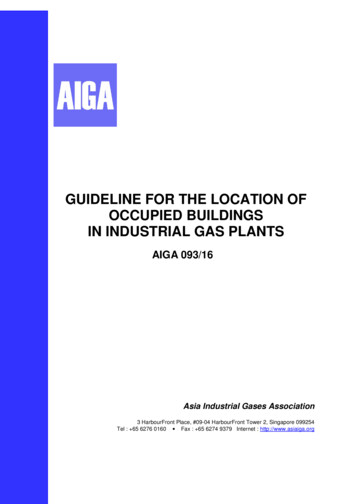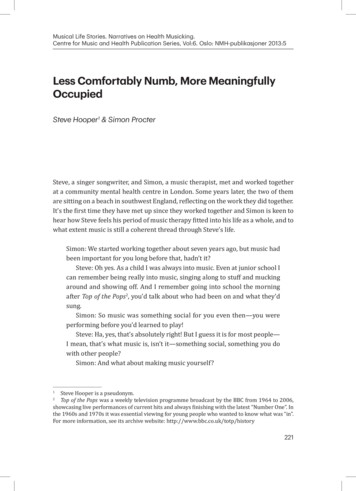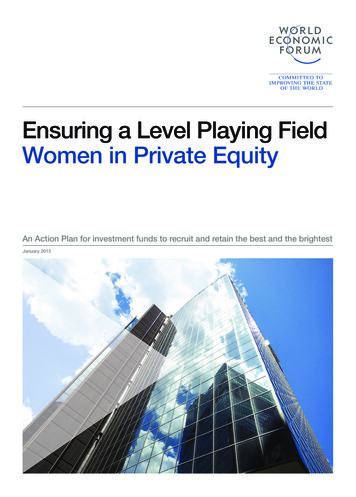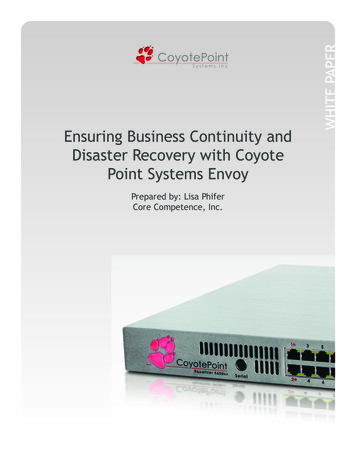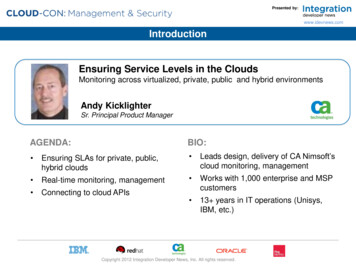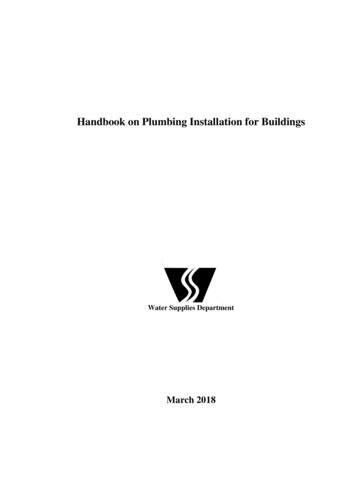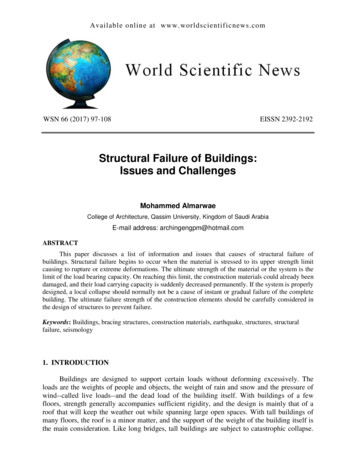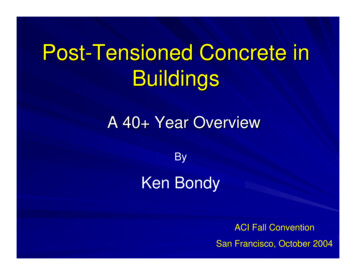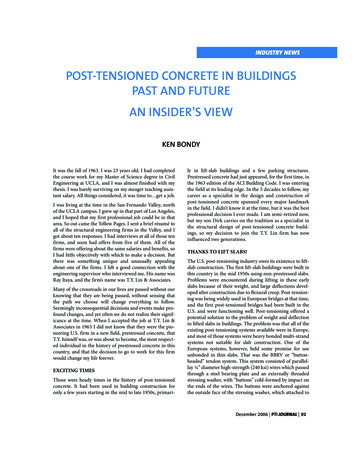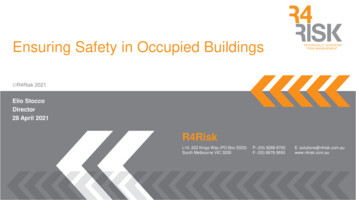
Transcription
Ensuring Safety in Occupied Buildings R4Risk 2021Elio StoccoDirector28 April 2021R4RiskL14, 222 Kings Way (PO Box 5023)South Melbourne VIC 3205P: (03) 9268 9700F: (03) 8678 0650E: solutions@r4risk.com.auwww.r4risk.com.au
Your Speaker Elio Stocco Director & Principal Risk Consultant CEng, RPEQ, Feng (TÜV Rheinland) Over 30 years’ experienceo Operations / process safety / risk management consulting Technical Expertise:o Hazard identification and risk assessment (HAZOP, SIL,LOPA, CHAZOP)o Safety case development and auditingo Emergency response planningo Fire, toxic and explosion modellingo Occupied buildings risk assessment25 May 2020 R4Risk 20212
R4Risk – Risk Management & Process SafetyTechnical Studies Hazard Identification (HAZOP, HAZID)Layer of Protection Analysis (LOPA)Safety Integrity Level (SIL)Fire Safety StudiesQuantitative Risk Assessment (QRA)Consequence AnalysisEmergency Response PlanningHazardous Area AssessmentOccupied Building Risk Assessment (OBRA)Process Safety Management Dangerous Goods ManagementMajor Hazard Facilities Safety ManagementProcess Safety Management StudiesSafety Case DevelopmentSafety Case Compliance AuditingSafety Case / Report Approved AssessorSafety Management System DevelopmentAccident InvestigationBusiness Risk Management 25 May 2020Business and Operational Risk ManagementEnterprise-Wide Risk ManagementTraining Process Safety and Risk Management TrainingRisk Mentoring R4Risk 20213
Overview Previous incidents– Fires, explosion and toxic events Describe the guidance to manage the risk to personnel insidebuildings Siting evaluation based on explosion R4Risk 20214
Flixborough: June 1, 1974 A vertical crack in reactor No.5 was leaking cyclohexane. Reactor was removed with a bypass assembly installed Bypass ruptured releasing a large quantity of cyclohexane Formed flammable vapour mixture found a ignition source 28 workers killed with 36 suffered injuries 18 fatalities in the collapsed control room R4Risk 20215
Jet Fire: Hickson & Welch, 1992 Clean operation was organised to remove residue from vessel used to distilorganic liquid in a batch process Residue (MNT, organic nitro products) was heated to assist removal Exothermic reaction within residue leading to the jet flame erupting frommanway, approx. 50 m Flame cut through an office / control building nearby Flame reached four-storey office block, shattering windows and setting roomson fire 5 workers killed and numerous injured R4Risk 20216
BP Texas City: 23 March 2005 Restarting of a hydrocarbon isomerisation unit Overpressure of flooded distillation tower causing a release from the vent stack Large flammable vapour cloud ( 19,000 m2 area) Suspected ignition source an idling diesel pickup truck 15 workers killed with 180 injured Majority of fatalities where personnel in trailers near vent stack R4Risk 20217
Texas City: Overpressure ImpactCSB (2007), "Investigation Report of Refinery Explosion and Fire, BP Texas City, Texas” R4Risk 20218
Toxic Releases Richmond, California USA (July 26, 1993)– Oleum release from tank car– Employees in the direct path sheltered indoors– No injuries reported to employees but 22 hospitalised in the community Nitro, West Virginia USA (December 5, 1995)– Release of a phosphorus chloride compound– Rain results in formation of HCl cloud that drifted off-site– 800 employees sheltered-in-place, no injuries reported Ludington, Michigan USA (February 7, 1993)– Release of bromine gas– Sheltered-in-place for 3 hours– No injuries R4Risk 20219
Management of Hazards for Occupied Buildings Guidance developed for building occupants– API RP 752: Location of Process Plant Buildings (2009)– API RP 753: Location of Process Plant Portable Buildings (2007, Reaffirmed Aug 2020) Planning strategies address different hazards:– Building collapse when subject to blast loads from explosion– Thermal hazards from fires– Ingress of toxic vapour Assessment approach– Consequence based– Risk based– Spacing tables R4Risk 202110
API RP-752:Location of Process Plant Buildings New and existing rigid structures permanently placed Management process for siting evaluations:––––Locate personnel away from process areasMinimise the use of buildings close to process areasManage occupancy within those buildings close to process areasBuildings intended for occupancy should be designed, constructed, modified andmaintained to protect against hazards– Manage the building occupancy as part of facility operation R4Risk 202111
API Assessment Approach Determine buildings to be included in assessment scope– Permanent / temporary / new Identify process hazards with potential to impact buildings– For each hazard, model related scenario(s) to determine impact Chose the building evaluation criteria– Consequence-based– Risk-based– Spacing tables R4Risk 202112
API Assessment Approach (Cont’d) Evaluate building response to determined level of impact Compare impact with building siting evaluation criteria For an existing building, mitigation options need to be considered whenthe criteria is not met Develop and implement the mitigation plan Personnel performing building site evaluation must have competence inanalysis techniques R4Risk 202113
API RP-752:Management of Change (MOC) Operator should identify the situations requiring MOC:– A new building intended for occupancy– Modification to existing building that may alter vulnerability to different events– Moving from not intended for occupancy to occupied– Change in number of personnel or time spent– Change in the process operation Hazardous material inventory New equipment R4Risk 202114
Siting of New Buildings For new buildings– Similar overall approach– The building is then designed to meet the building siting evaluation criteria R4Risk 202115
API RP-753:Location of Portable Buildings Portable buildings– Offices, Training Rooms, Conference Rooms, Change houses Guiding principles similar to API RP-752– Modified for portable buildings Restrictions on personnel– Only essential personnel are allowed close to process units– Placement requires detailed analysis Guidance for explosion hazards– Zones R4Risk 202116
Consequence-Based or Risk-based Consequence –Based Approach Risk–Based Approach In scenario development both consider:– Site specific data: material, inventories, operating conditions, process layout– Industry knowledge on history of incidents at similar sites R4Risk 202117
Evaluation of Existing Building Siting Identify VCE scenarios within plant Assess potential for VCEs to impact existing buildings Determine blast loads experienced by building Results compared with siting evaluation criteria R4Risk 202118
Evaluating Location Based on Blast21 R4Risk 2021319
Building Damage CurvesUS DDESB (2009), "Approve methods and algorithms for DOD Risk-Based Explosive siting" R4Risk 202120
Evaluating Location Based on Blast2 R4Risk 202121
Evaluating Location Based on Blast1 R4Risk 2021322
Mitigation Options Hierarchy of Mitigation Measures Passive Active Procedural Typical option used– Reduce consequence of release However this maybe difficult to do as process is normally fixed– Strengthening of building Requires detailed structural analysis– Relocation of personnel to alternate locations Non-essential v. Essential– Abandon the building R4Risk 202123
Conclusions Use industry developed guidance for locating buildings in process areas– Existing buildings should be checked– Ensure siting evaluation is undertaken for portable buildings Manage building occupancy as part of facility’s operation through theMOC process Use experts to apply building siting evaluation R4Risk 202124
Upcoming EventsWebinarsOnline Live Trainingo Linking Risk Assessments to ProcessSafety Management (May 26 2021)o Introduction to LOPA (19 – 20 May2021)o After the Bowties – The Storyo Risk Assessment Leader (25 – 28Continues (29 June 2021)May 2021)o Fire Safety Studies (29 July 2021)o Introduction to Process Safety (22 –23 June 2021)For more information and registration, visit www.r4risk.com.au or contact solutions@r4risk.com.au R4Risk 202125
Q&A Session R4Risk 202126
API RP-752: Location of Process Plant Buildings New and existing rigid structures permanently placed Management process for siting evaluations: –Locate personnel away from process areas –Minimise the use of buildings close to process areas –Manage occupancy within those buildings close to process areas –Buildings intended for occupancy should be designed, constructed, modified .
